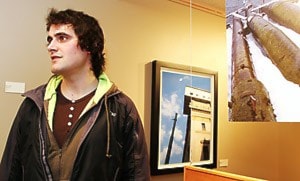Tytus Hardy and Rosemary Scanlon like to let things get in their way.
Take the pair’s latest photography exhibition, Obstruction, for example.
Photos face every which way.
Some hang on the walls, some hang from, and hide behind, thick planks of wood and some sit facing upward on handmade plinths.
In fact, the exhibition’s first image is literally blocked by a thick plank of wood hanging from the ceiling.
“It obstructs the viewer from a direct view of the photo,” said Scanlon in an interview from Montreal.
(Scanlon, a Quebecois by birth, was unable to make the exhibition opening at the Arts Underground in downtown Whitehorse because she was busy working on new paintings in Montreal.)
“It forces the viewer to look at the photo in a different way — like photographers look at the world in a different way,” said Scanlon.
Viewers must navigate the obstructions to appreciate the artwork.
Hardy used the idea of a labyrinth when planning the installation.
“My mother told me that a maze is meant to confuse you, while a labyrinth is meant to relax you,” said Hardy on Friday afternoon during the show’s opening at the Yukon Art Society gallery in Arts Underground.
The photos face several different directions so the experience of the artwork change as the viewer moves through the space — just as a person’s viewpoint and perception changes as they move through a city, said Hardy.
A city’s layout often obstructs a person’s view and their freedom.
The densely packed buildings, roads and infrastructure define what someone can see and where they can go.
It’s a tool that city planners have been using for centuries, explained Hardy.
For example, when New York City was expanding, overpasses were intentionally built too low for buses to pass beneath.
This made sure that only residents who could afford cars can reach certain parts of the city, he said.
Hardy used handcrafted wooden blocks to represent those everyday obstructions.
The block is the most basic unit of construction, explained Hardy.
Buildings are made from rectangular shapes — the smallest building block is a brick or a two-by-four stud.
Buildings are also made in rectangular shapes — from towering skyscrapers to the two flat planes that meet at a crux to make a triangular roof.
The photographs are images from cities, but Hardy and Scanlon have shunned the more traditional skylines in favour of a simpler approach.
They celebrate the small forgotten spaces that are usually lost amid the big city bustle.
The subject matter is varied. It captures objects as simple as the play of light on the concrete bricks atop a stairwell; a streetlight cutting a perfect incision through a cloudless sky and a jumbled pile of odds and ends in a Yukon yard.
Each photograph invokes the idea of peace and silence in some of the world’s busiest cities — Paris, Montreal, St. Petersburg, Russia, Tallinn, Estonia.
Hardy’s favourite image, shot while strolling around St. Petersburg with his mother, hangs at the back of the gallery.
It shows a slumped asymmetrical children’s slide pictured in the distance through a bracket of trees and fence posts.
“There are a lot of places like this in Russia that don’t really look like playgrounds,” he said.
Scanlon’s favourite photo sits directly below.
The image looks up onto the side of a dreary concrete-slab apartment building sprinkled with satellite dishes that poke out like plants from the balconies.
“I had no idea that it was going to be such a cold photo,” said Scanlon.
“But if you think of each square as holding a life and a family, it becomes a different image.”
Hardy and Scanlon met while in university at Concordia and now work as partners in both life and in art.
“He had seen my work and I had seen his and we were both dealing with similar elements,” she explained.
Scanlon began her artistic career as a painter but started shooting photos when a job with the company American Apparel sent her travelling all over North America, and her paints and easel were too cumbersome to tote around.
“Photography allowed for a more immediate response to my surroundings,” she said.
Meanwhile, Hardy honed his photographic skills while travelling and studying in Siberia over eight months.
Hardy has also taken many cues from his parents.
He learned his woodworking skills from his father (NDP leader Todd Hardy) who is a carpenter by trade.
He and his brother baked all the fancy foods for the opening reception, a skill they learned from their mother.
Obstruction closes on Wednesday, January 31.
